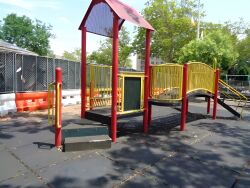Havemeyer Playground
Havemeyer Playground
What was here before?
This playground is in the Unionport section of the Bronx. In the early 1900s, it was one of the Westchester towns that became part of the Bronx and resembled a frontier town. Unlike the cultivated estates of Morrisania and West Farms, Unionport was characterized by dirt roads, wooden sidewalks, frame houses with hitching posts, and taverns.
In 1948, construction started on the Cross-Bronx Expressway, a six-lane highway across the South Bronx. Completed in 1963, it was one of Robert Moses’s most controversial undertakings. Hundreds of apartment buildings and many one- and two-family houses were demolished to make way for the new thoroughfare, forcing thousands of Bronx residents to seek new homes. The neighborhood took on a new character as high-rise housing projects replaced the smaller buildings and local streets became exit ramps for the highway.
How did this site become a playground?
During the construction of the Cross-Bronx Expressway, a series of grassy strips were slated for park use alongside the new roadway. In 1946, the Board of Estimate transferred control of these parcels to NYC Parks, which immediately began plans for the construction of play areas.
This playground opened in 1956 and was originally called Playground No. 30 before it was officially recognized as Havemeyer Playground. The playground features a single basketball court, play equipment, a statue of a seal, and a new public restroom.
Who is this playground named for?
This Unionport playground is named for the Havemeyers, an influential 19th century family of businessmen and politicians.
In 1644, Hermann Hoevemeyer was recognized in Germany as the organizer of the first baker’s guild. In 1799, descendant Wilhelm Hoevemeyer immigrated to the United States and entered the sugar industry, followed by the rest of his family. By the time his grandsons inherited the business, the now-“Havemeyer” family’s sugar refineries were located in Williamsburg, Brooklyn, where the family was locally referred to as the “Sugar Kings.”
In 1828, William Frederick Havemeyer began managing the family business, but he also enjoyed a vibrant political career. Elected in 1845, and again in 1848, he served two non-consecutive terms as Mayor of New York. A popular Democrat and member of Tammany Hall, Havemeyer earned a reputation as a calculating financial manager. Briefly returning to the family business after his second term as Mayor, Havemeyer became disgusted with the scandals surrounding the Tweed Ring. He was elected Mayor a third time in 1872, this time on the Republican ticket, with high voter approval. He died in office two years later at the age of 68.
William Havemeyer’s grandsons, Theodore and Henry Havemeyer, continued the family’s legacy and monopolized the sugar industry until the family’s stranglehold on the sugar business gradually declined. In 1900, the Odd Fellows, a Masonic national organization that established a chapter in Unionport, began encouraging local politicians to honor the family’s legacy. Shortly thereafter, the Bronx’s Avenue B was renamed Havemeyer Avenue.
Check out your park's Vital Signs
Clean & Safe
Green & Resilient
Empowered & Engaged Users
Share your feedback or learn more about how this park is part of a
Vital Park System




